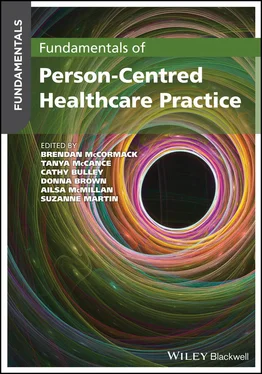What is person‐centred practice?
Person‐centredness reflects the ideals of humanistic caring in which there is a moral component, and practice has at its basis a therapeutic intent, which is translated through relationships that are built on effective interpersonal processes. Buetow (2016) discusses caring from the perspective of a physician as ‘a moral value and an ethical practice defining a connectedness with, and respectful and concerned attention to, concrete needs of others and oneself’ (p. 104). This philosophical position has resonance across the caring professions and reflects models for developing person‐centred healthcare that fundamentally take account of the humanness of people.
Despite this shared philosophical position, professional groups use a variety of different models and theories to underpin their practice. Within nursing, the use of models has evolved over time, ranging from those based on activities of daily living (Roper et al. 2000) to those that are more relationships centred (Peplau 1997) and many more besides (Fitzpatrick and Whall 2016). The allied health professions have also drawn on a variety of models and theories ranging from the traditional medical model, to biopsychosocial models such as the International Classification of Functioning, Disability and Health (ICF) (WHO 2001) and moving towards the integration of social models for health and well‐being.
Social models of health recognise that our health is influenced by a wide range of individual, interpersonal, organisational, social, environmental, political and economic factors. They encourage us to have a deeper understanding of health: ‘Health, and what makes people healthy, can only be fully understood by exploring the myriad of interactions and influences that emerge out of the complexities of human experience and the various inter‐relationships of the mind, body and society’ (Yuill et al. 2010, p. 14). Irrespective of the models or theories that guide practice (and as reflected in Chapter 2), we advocate the importance of the underpinning values of person‐centredness, where the core value of ‘respect for the person’ is paramount.
Person‐centredness in practice requires the formation of therapeutic relationships among professionals, patients and others significant to them in their lives. It is generally accepted that the principles underpinning person‐centredness as an approach focus on treating people as individuals; respecting their rights as a person; building mutual trust and understanding; and developing positive relationships. Furthermore, these principles reflect a standard of care that practitioners aspire to in their professional practice. The challenge, however, continues to be how these principles are translated into everyday practice to enable multiprofessional teams to deliver this standard of care consistently over time (Mitchell et al. 2015; Wolf et al. 2017; Sharp et al. 2018).
The Person‐centred Practice Framework described in this chapter was originally born out of a desire to operationalise person‐centredness in a way that would illuminate practice, and provide practitioners with a language that would enable them to name components of person‐centredness, and the barriers and enablers that influence its development in the workplace.
Introducing the Person‐centred Practice Framework
This book is based around the Person‐centred Practice Framework of McCormack and McCance (2017) and is built upon similar values underpinning separate research by both authors.
When they conducted their original research (McCance et al. 1999, 2003; McCormack 2001a,b), McCormack and McCance worked through a humanistic caring lens. McCance made these values explicit in her research on caring, where she identified the key relational focus of care that enabled nurses to connect with other persons and practise effectively. An understanding of human caring was critical to this research and the conceptual and theoretical analysis undertaken by McCance et al. (1999) highlighted the dual nature of caring represented by attitudes/values on the one hand and activities on the other, but with the greatest importance placed on the practitioner–patient relationship. This represents a view of persons embedded in a humanistic tradition reflecting principles including the centrality of human freedom, choice and responsibility; holism whereby persons are interconnected with others and nature; different forms of knowing; and the importance of time and space, and relationships (Watson 1985).
Similarly, McCormack (2001b) focused on the autonomy of persons as a core value. He first problematised autonomy and demonstrated its limitations from behavioural and transcendental perspectives. Then, he identified relational ethics as being critical to demonstrating respect for another person. His research was influenced by humanistic theory that emphasised the centrality of a person’s beliefs, values and human desires as core to effective decision making and to ‘knowing the person’.
Although she didn't place her research in the same framework as McCormack and McCance, or draw on the same philosophical ideas, Dewing (2012) also adopted a broadly humanistic approach to her research with older persons living with dementia in response to a dominant behaviourist paradigm. Dewing (2012) drew on philosophical ideas about persons and ‘being in the world’ that challenged the way persons with dementia are viewed as having abnormal, problematic or challenging behaviours. Considering who we are in terms of our bodies and how we use them to be a person, relationships with things or others that matter to us and relationships with time and space/place all offer very different perspectives on what it can mean to be a person. When reading about the Person‐centred Practice Framework, it is important to be aware of the dominant philosophical perspectives articulated through the framework as this has shaped its development and may also influence yours!
The development of the Person‐centred Practice Framework has spanned over a decade and during that time it has been used in a variety of different ways, across a range of contexts. The framework was developed for use in the intervention stage of a large quasi‐experimental research study, which focused on measuring the effectiveness of the implementation of person‐centred nursing in a tertiary hospital setting (McCormack et al. 2008). The Person‐centred Practice Framework is more than a conceptual model, but has been described as a middle‐range theory (McCormack and McCance 2016). In simple terms, this means that the framework is less abstract than a conceptual model as it comprises concepts that are relatively specific, and outlines relationships between the concepts. You will see these relationships within the framework unfold in the remainder of this chapter.
Whilst the framework has its origins in nursing practice and is described in a nursing version of the framework (the Person‐centred Nursing Framework), the Person‐centred Practice Framework is situated within healthcare systems more broadly. The version of the Person‐centred Practice Framework presented in this book is the latest iteration and reflects recent changes made to ensure applicability to a wide range of healthcare workers across multiple contexts. It continues to be tested and refined through an ongoing programme of applied research within a multidisciplinary context ( www.cpcpr.org/resources).
The Person‐centred Practice Framework comprises four main domains: prerequisites , which focus on the attributes of staff; the practice environment , which focuses on the context in which healthcare is experienced; the person‐centred processes , which focus on ways of engaging that are necessary to create connections between persons; and the outcome , which is the result of effective person‐centred practice. The relationships between the four constructs of the Person‐centred Practice Framework are represented pictorially so that, to reach the centre of the framework, the attributes of staff must first be considered, as a prerequisite to managing the practice environment and in order to engage effectively through the person‐centred processes. This ordering ultimately leads to the achievement of the outcome – the central component of the framework. It is also important to recognise that there are relationships and overlap between the constructs within each domain.
Читать дальше












